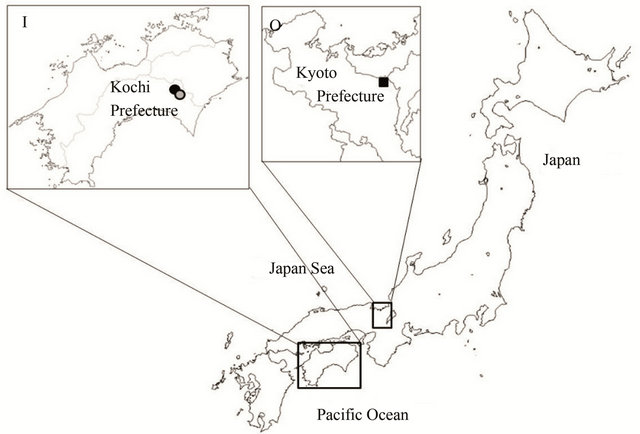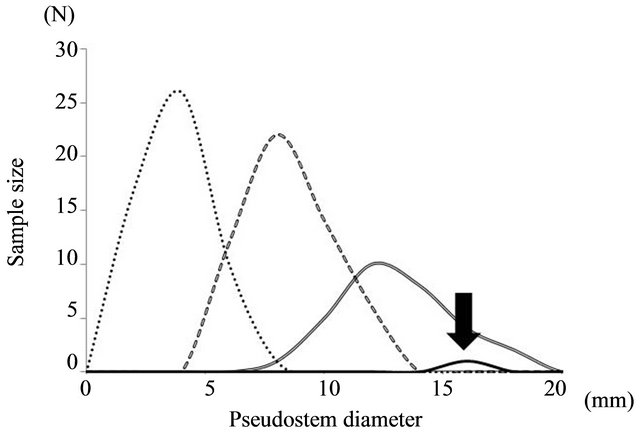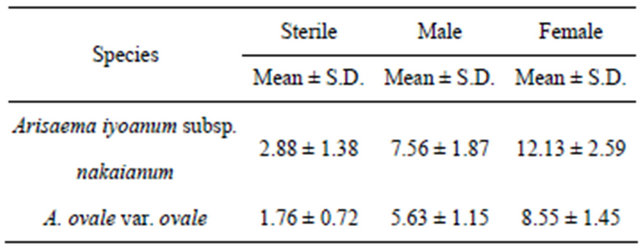American Journal of Plant Sciences
Vol.4 No.1(2013), Article ID:27605,4 pages DOI:10.4236/ajps.2013.41006
Variation in the Leaf Number of Arisaema iyoanum subsp. nakaianum and A. ovale var. ovale (Araceae)
![]()
1Graduate School of Integrated Arts and Sciences, Kochi University, Nankoku, Japan; 2Faculty of Agriculture, Kochi University, Nankoku, Japan; 3Faculty of Science, Yamagata University, Yamagata, Japan.
Email: *tfukuda@kochi-u.ac.jp
Received October 4th, 2012; revised November 20th, 2012; accepted December 27th, 2012
Keywords: Arisaema iyoanum subsp. nakaianum; A. ovale var. ovale; Leaf Number
ABSTRACT
Arisaema iyoanum Makino subsp. nakaianum (Ohba) H. Ohashi et J. Murata and A. ovale Nakai var. ovale are known to have one-leaved phenotype in both males and females; however, we discovered two-leaved individuals of these species. To elucidate the relationship between growth stage and leaf number of A. iyoanum subsp. nakaianum and A. ovale var. ovale, we conducted a morphological analysis of these plants. Our analysis suggested that the two-leaved individuals of A. iyoanum subsp. nakaianum and A. ovale var. ovale appeared only at the female phase. This suggested that one-leaved A. iyoanum subsp. nakaianum and A. ovale var. ovale individuals could not store the resources and hence changed to two-leaved individuals. This transformation could be explained by the fact that these species occur at high altitudes in mountain areas or regions covered in snow of the Japan Sea side, and their flowering time is also late compared with that in other sympatric Arisaema species.
1. Introduction
Araceae is a large family of mostly herbaceous plants, with a great variety in vegetative habit. This family mainly includes herbaceous plants with aerial stems or underground tubers or rhizomes, as well as a few woody members. Arisaema is a genus of the Araceae family that includes about 150 species that are found in eastern and central Africa, Asia, and eastern North America [1]. Arisaema includes perennial plants that are typically male when young and female or hermaphroditic when fully grown. The sex of a plant changes depending on resources conditions, and a single plant can change its sex several times during its life-span (e.g., [1-3]). In general, most species in the section Pedatisecta in Arisaema have constant numbers of leaves either one or two. The section Pedatisecta is the spring ephemeral, which flower in early spring and store the resources for a limited period [3]. Among them, however, Arisaema tosaense Makino has characteristic leaf numbers, with both oneand two-leaved plants. Muramatsu et al. [4] reported that one-leaved individuals of A. tosaense appeared at the beginning of both male and female phases, suggesting that they contribute to the earlier appearance of the fertile phase from sterile phase. Considering the result of the leaf number of A. tosaense, Arisaema species described as one-leaved may have the potential to become two-leaved during its life-span.
Arisaema iyoanum Makino subsp. nakaianum (Ohba) H. Ohashi et J. Murata and A. ovale Nakai var. ovale are mainly one-leaved [1]. The former is distributed in the high altitudes of the mountain areas of Shikoku, and the latter occurs in the Japan Sea side of the limited mountain areas of Honshu, Japan [3,5,6], where it remains covered with snow during winter to spring. Interestingly, we found two-leaved individuals of A. iyoanum subsp. Nakaianum and A. ovale var. ovale (Figure 1) in different areas of Japan. Hence, we attempted to elucidate whether the number of leaves varies from one to two leaves during the male to female transition of these plants. Nonetheless, determining the growth stage of Arisaema species is difficult. Bierzychudek [2] indicated that the leaf area of Arisaema species was correlated to their growth stage. In addition, Takasu [7] suggested high correlations of the leaf area with the leaflet number, biomass, and pseudostem diameter in Arisaema species. Therefore, we thought that the pseudostem diameter in field could reflect the growth stage of Arisaema species. The relationship between leaf number and growth stage

Figure 1. A two-leaved individual of Arisaema ovale var. ovale. Arrows indicate leaves.
(sexual stage) of A. iyoanum subsp. nakaianum and A. ovale var. ovale was determined by conducting a morphological analysis of these species during their growth stage (pseudostem diameter measurement).
2. Materials and Methods
In this study, A. iyoanum subsp. nakaianum were analysed between April and June 2012 and A. ovale var. ovale were analysed in May 2011. In all, 120 sterile plants (54 A. iyoanum subsp. nakaianum; 66 A. ovale var. ovale), 108 males (54 A. iyoanum subsp. nakaianum; 54 A. ovale var. ovale), and 63 females (31 A. iyoanum subsp. nakaianum; 32 A. ovale var. ovale) plants were marked using numbered and staked wire flags in the Kyoto Prefecture (A. ovale var. ovale) and Kochi Prefecture (A. iyoanum subsp. nakaianum) (Table 1, Figure 2). The pseudostem diameter of the plants was measured using a digital calliper (Mitutoyo), and the sexual state of each plant was recorded during the growing season.
3. Results and Discussion
Our results indicated that the pseudostem diameters of sterile, male, and female individuals of A. iyoanum subsp. nakaianum ranged from 0.64 to 6.88, 4.2 to 11.71, and 6.09 to 17.63 mm (Figure 3(a), Table 2), and those of A. ovale var. ovale ranged from 0.29 to 3.86, 3.66 to 8.37, and 6.1 to 11.56 mm (Figure 3(b)), respectively. The pseudostem diameter of A. iyoanum subsp. nakaianum with 2 leaves was 14.48 mm and those of A. ovale var. ovale were 7.88 and 8.24 mm during the female phase.
These results suggested that the generally one-leaved individuals of A. ovale var. ovale and A. iyoanum subsp. nakaianum became two-leaved at the female phase; however, the rate of appearance of two-leaved individuals was very low (A. ovale var. ovale: 1.32%; A. iyoanum subsp. nakaianum: 0.72%). The reason for the appear-

Figure 2. Sampling localities of this study. I: Arisaema iyoanum subsp. nakaianum; O: A. ovale var. ovale. Black circle indicates Kochi Pref., Kami city, Monobe-cho Kubokage; Gray circle indicates Kochi Pref., Kami city, Monobe-cho befu; Black square indicates Kyoto Pref., Nantan city, Miyama-cho, Ashiu.
 (a)
(a) (b)
(b)
Figure 3. Relationship between growth stage and pseudostem diameter. Dotted line indicates the sterile phase, white short dashed line is the male phase with one-leaf, gray line is the female phase with one-leaf, and black line is the female phase with 2 leaves. Arrows indicate the female phase with 2 leaves. (a) Arisaema iyoanum subsp. Nakaianum; (b) A. ovale var. ovale.
Table 1. Sampling localities.

Table 2. Pseudostem diameter (mm) of sterile, male, female in Arisaema iyoanum subsp. nakaianum and A. ovale var. ovale.

ance of two leaves in A. ovale var. ovale and A. iyoanum subsp. nakaianum during the female phase was not clear. One of the reasons could be that the resources to produce an additional leaf could not be stored, although the single leaf of A. ovale var. ovale and A. iyoanum subsp. nakaianum is very large and can store many resources. A. ovale var. ovale is distributed in the Japan Sea side of Honshu, and the climate of this region differs from that of the Pacific Oceanic side because Japan has a lofty backbone range that extends along the axis of Honshu and divides the island into the Japan Sea side and the Pacific Oceanic side. The Japan Sea side receives considerable snow and has late spring. On the other hand, A. iyoanum subsp. nakaianum occurs in the high altitude of the mountain areas of Shikoku, and its flowering time is late compared with that of other sympatric Arisaema species [3,8]. From similar environmental conditions of flowering time in different areas, A. ovale var. ovale and A. iyoanum subsp. nakaianum could not be easily to store in the resources of appearing two leaves. The resources of A. ovale var. ovale and A. iyoanum subsp. nakaianum could not be stored efficiently in the male phase, and there was no need to produce an additional leaf; however, during the shift from male to female phase, the stored resources in the female phase were used to not only produce seeds and fruits but also form an additional leaf. Thus, most A. ovale var. ovale and A. iyoanum subsp. nakaianum species are one-leaved during the female phase, and appearance of two-leaved individuals at this phase is very rare. In addition, our results indicated that the rate of appearance of two-leaved individuals of A. ovale var. ovale and A. iyoanum subsp. nakaianum was lower than that of A. tosaense ([4]: 58.45%), which has both oneand two-leaved individuals. A. tosaense plants occur at lower or the same altitude as that of A. iyoanum subsp. nakaianum, but the former occur at lower altitude than the latter; hence, A. tosaense can easily store resources compared to A. iyoanum subsp. nakaianum. In a short spring season with environmental conditions such as high altitude and considerable snow, one-leaved Arisaema species could have better fitness than the two-leaved individuals.
Recent studies have reported interspecific hybrids among Arisaema species on the basis of morphological and molecular analyses. For example, Maki and Murata [9] indicated that A. ehimense J. Murata et Ohno is a hybrid origin between A. serratum (Thunb.) Schott and A. tosaense. Moreover, Hayakawa et al. [10-12] reported the formation of hybrids and introgressions between A. sikokianum and A. tosaense and between A. sikokianum and A. japonicum Blume (recognized as A. serratum in [12]). These results suggested that interspecific hybrids could be easily generated using Arisaema species. It would be interesting to determine the leaf number of interspecific hybrids between A. ovale var. ovale or A. iyoanum subsp. nakaianum and two-leaved Arisaema species.
4. Acknowledgements
We wish to thank Prof. emeritus H. Watanabe for allowing us to examine Arisaema ovale var. ovale in Ashiu Forest Research Station of Field Science Education and Research Center, Kyoto University, and Drs. Y. Minamiya, A. Hirata, R. Ueda, M. Saito, K. Ohga, M. Muroi, S. Isomoto, Y. Kumekawa, Y. Yoshimi, H. Miyata, Y. Tsuchiya, and N. Yokoyama for providing additional help. This study was partly supported by a Grantin-Aid for Scientific Research from the Ministry of Education, Science and Culture of Japan (to T. F. and J. Y.).
REFERENCES
- H. Ohashi, “Araceae,” In: Y. Satake, J. Ohwi, S. Kitamura, S. Watari and T. Tominari, Eds., Wild Flowers of Japan Vol. I, Heibonsha, Tokyo, 1982, pp. 127-139.
- P. Bierzychudek, “Determinations of Gender in Jackin-the-Pulpit: The Influence of Plant Size and Reproductive History,” Oecologia, Vol. 65, No. 1, 1984, pp. 14-18. doi:10.1007/BF00384456
- J. Murata, “The Picture Book of Plant Systematics in Color”, In: J. Murata, Ed., Arisaema in Japan, Hokuryu- kan, Tokyo, 2011.
- Y. Muramatsu, K. Matsuyama, H. Hayakawa, Y. Minamiya, K. Ito, R. Arakawa and T. Fukuda, “Correlation between Sex Stages and Leaf Numbers in Arisaema tosaense Makino (Araceae),” American Journal of Plant Science, Vol. 3, No. 1, 2012, pp. 114-118. doi:10.4236/ajps.2012.31012
- J. Murata, “Example of Valuable Species in Fukui Prefecture: Arisaema ovale var. ovale,” Bulletin of the Fukui Botanical Garden, No. 1, 1996, pp. 13-17.
- H. Watanabe, “Plants in Ashiu,” In: H. Watanabe, Ed., Fauna and Flora of Ashiu Forest, Nakanishiya, Kyoto, 2008, pp. 15-48.
- H. Takasu, “Life History Studies on Arisaema (Araceae) I. Growth and Reproductive Biology of Arisaema urashima Hara,” Plant Species Biology, Vol. 2, No. 1-2, 1988, pp. 29-56. doi:10.1111/j.1442-1984.1987.tb00031.x
- J. Murata, “Diversity in the Arisaema serratum Group,” Acta Phytotaxonomica et Geobotanica, Vol. 46, No. 2, 1995, pp. 185-208.
- M. Maki and J. Murata, “Allozyme Analysis of the Hybrid Origin of Arisaema ehimense (Araceae),” Heredity, Vol. 86, 2001, pp. 87-93. doi:10.1046/j.1365-2540.2001.00813.x
- H. Hayakawa, H. Hamachi, Y. Muramatsu, A. Hirata, Y. Minamiya, K. Matsuyama, K. Ito, J. Yokoyama and T. Fukuda, “Interspecific Hybridization between Arisaema sikokianum and A. tosaense (Araceae) Confirmed through Nuclear and Chloroplast DNA Comparisons,” Acta Phytotaxonomica et Geobotanica, Vol. 61, No. 2, 2010, pp. 57-63.
- H. Hayakawa, H. Hamachi, K. Matsuyama, Y. Muramatsu, Y. Minamiya, K. Ito, J. Yokoyama and T. Fukuda, “Introgressive Hybrids of Arisaema sikokianum and A. tosaense (Araceae) Confirmed through Nuclear and Chloroplast DNA Comparisons,” American Journal of Plant Science, Vol. 2, No. 3, 2011, pp. 303-307. doi:10.4236/ajps.2011.23034
- H. Hayakawa, H. Hamachi, K. Matsuyama, Y. Muramatsu, Y. Minamiya, K. Ito, J. Yokoyama and T. Fukuda, “Interspecific Hybridization between Arisaema sikokianum and A. serratum (Araceae) Confirmed through Nuclear and Chloroplast DNA Comparisons,” American Journal of Plant Science, Vol. 2, No. 4, 2011, pp. 521- 526. doi:10.4236/ajps.2011.24061
NOTES
*Corresponding author.

